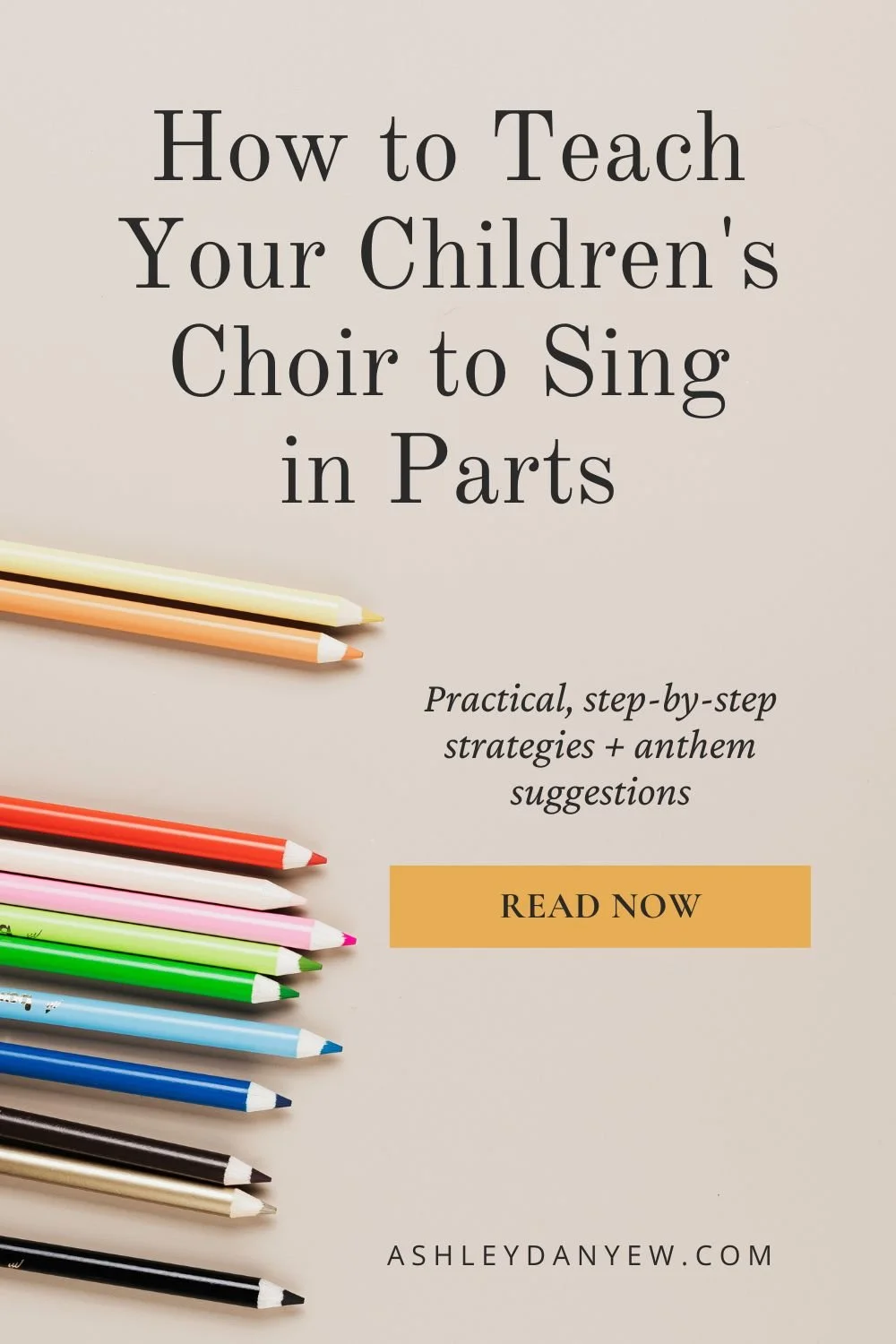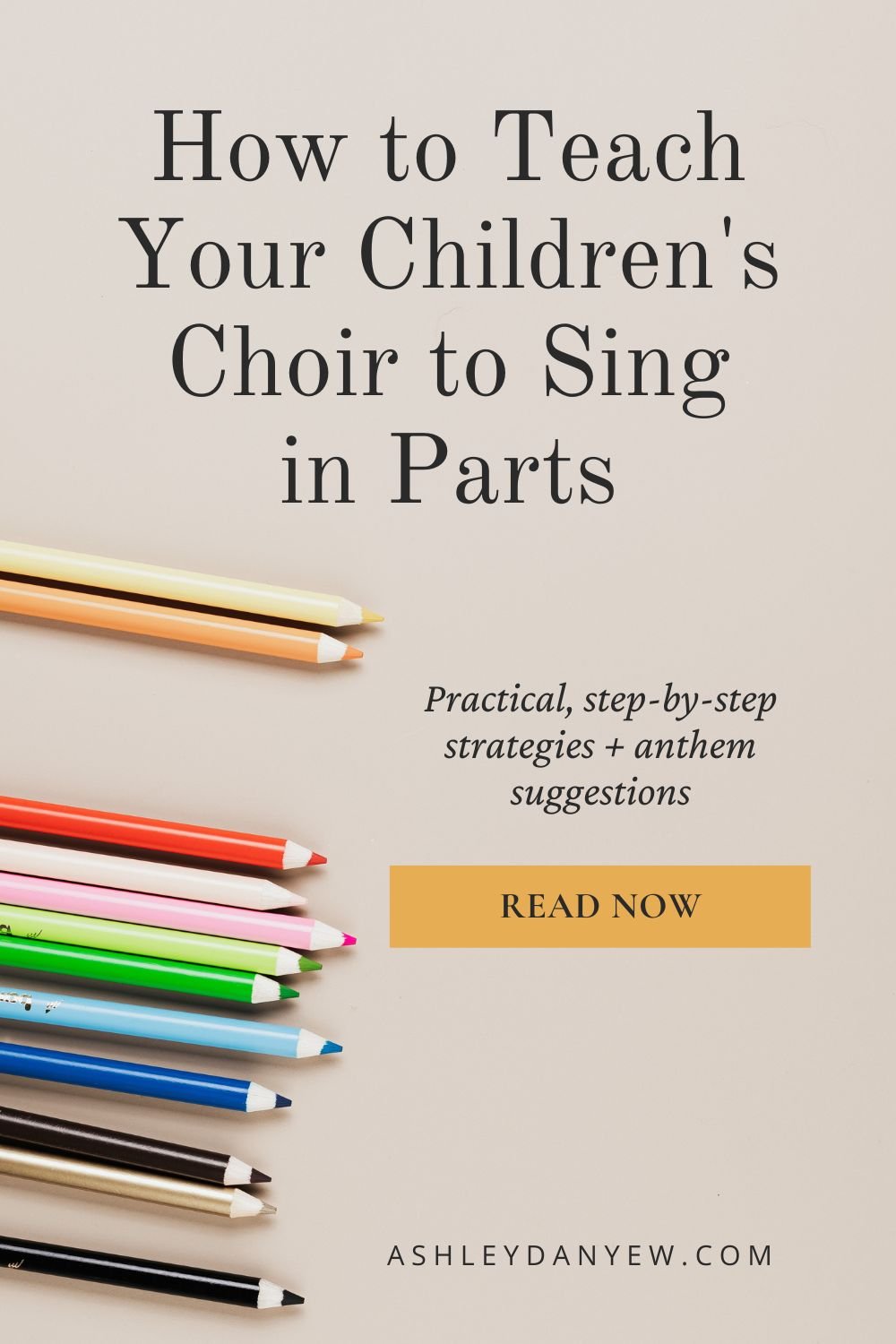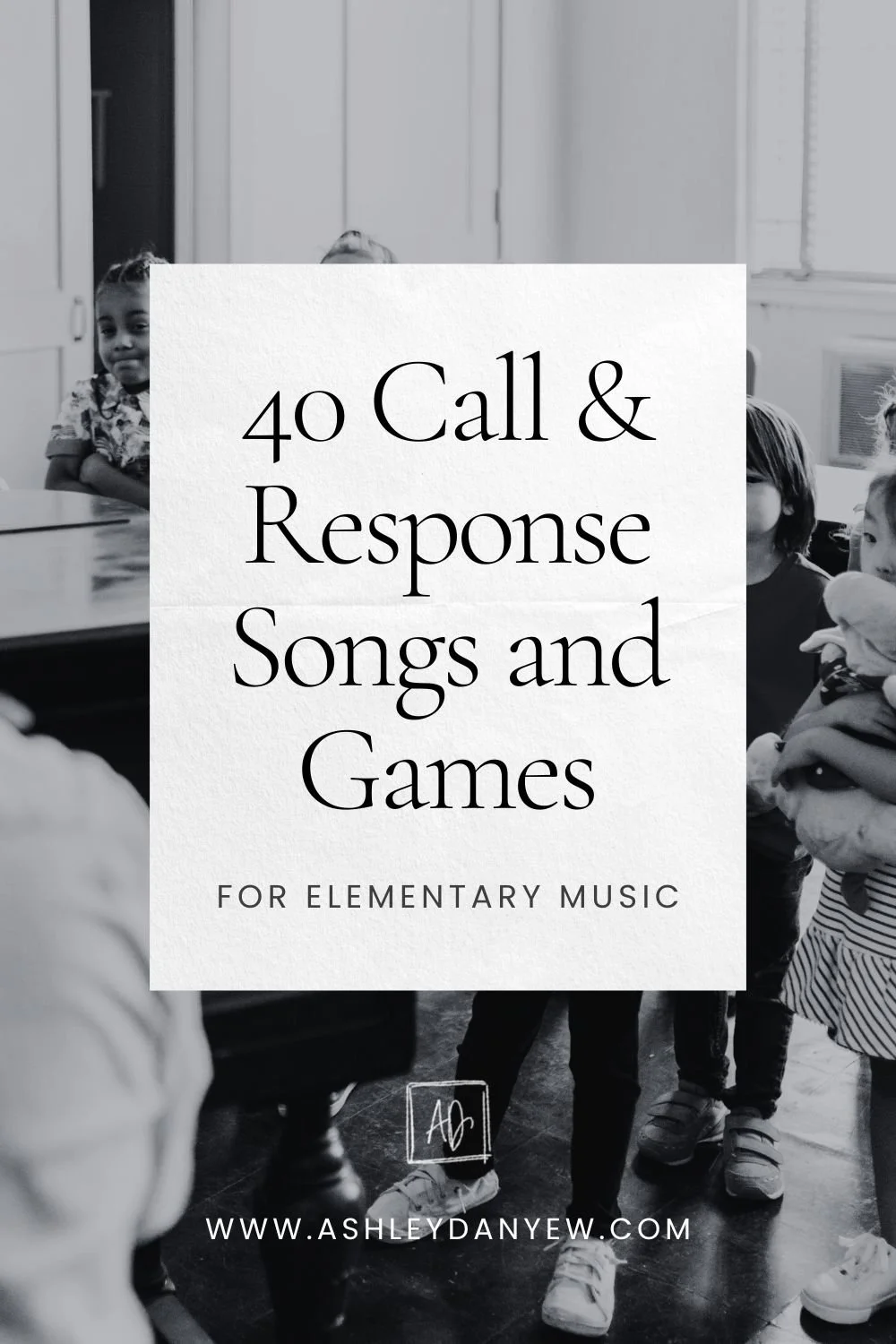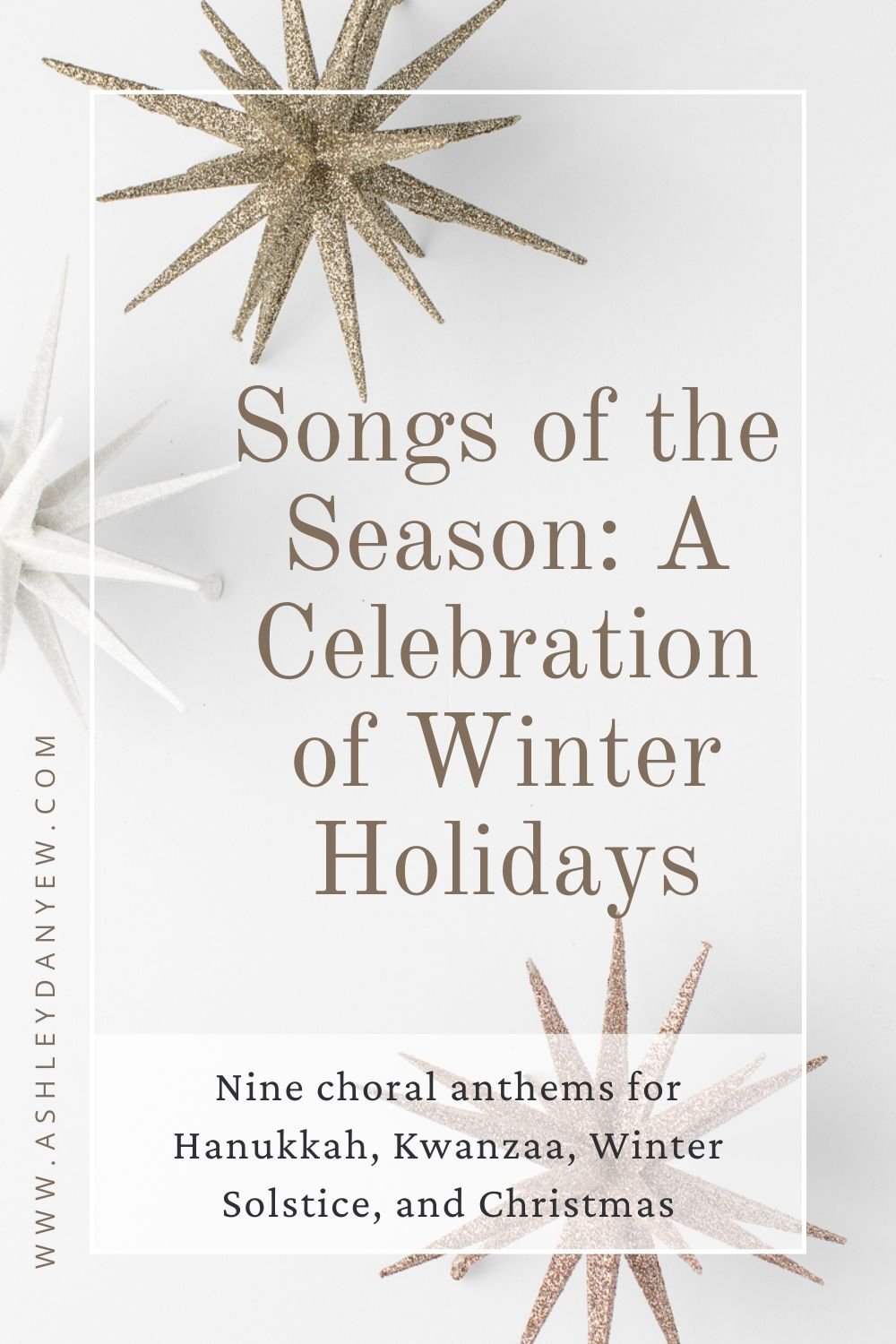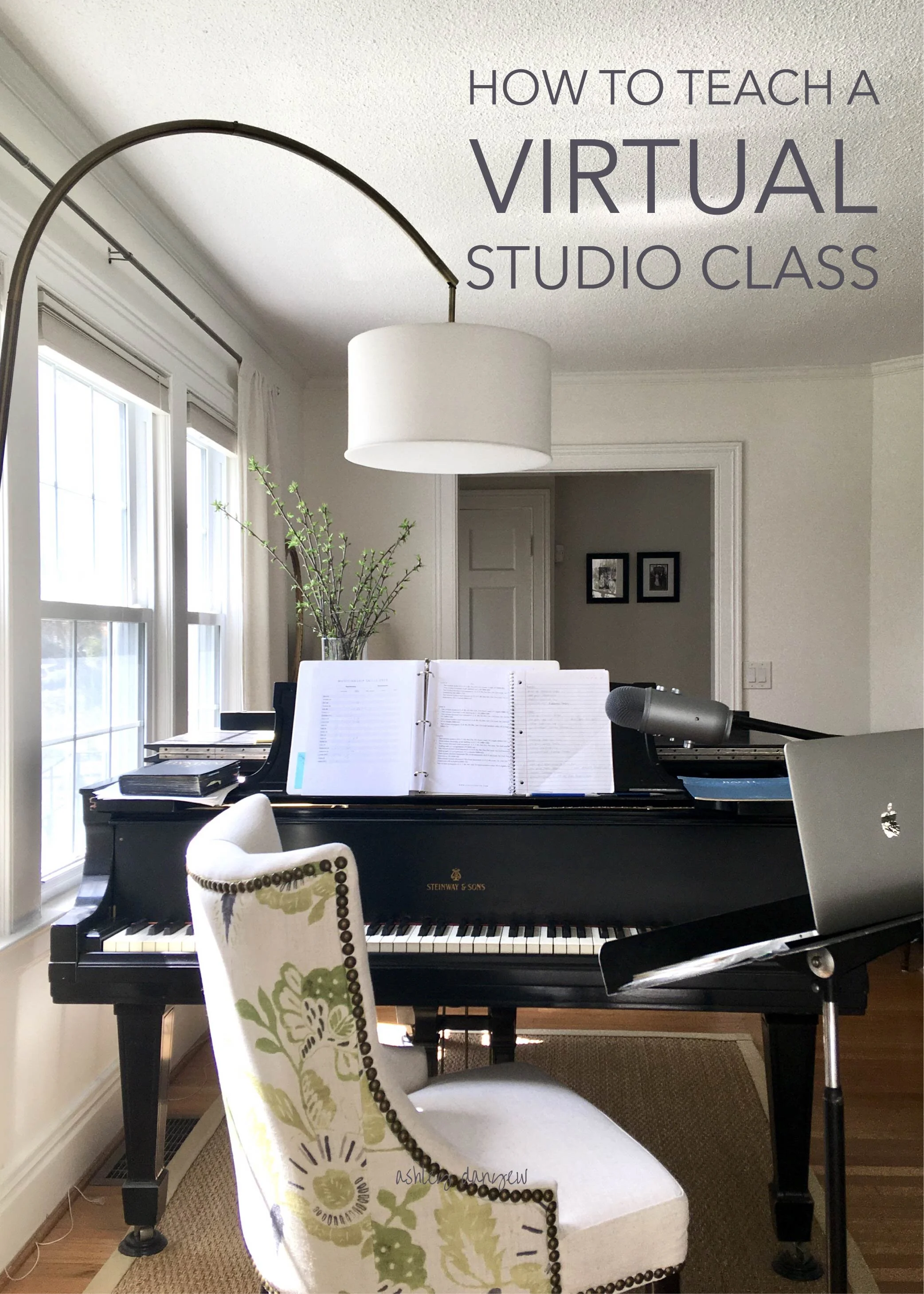Part-singing is one of the great joys of choral singing.
The challenge of singing an independent line and that satisfying feeling of creating harmony and musical interest is both fun and motivating for singers (of all ages!).
But how do you teach that?
How do you introduce part-singing to your children’s choir or elementary music class? How do you know if your young singers are ready to sing in parts?
In this post, I’ll share a few helpful tips for helping your singers develop the musical independence necessary to sing in parts successfully, a few introductory steps for getting started, and some of my favorite unison/2-part anthem suggestions.
*Disclosure: I get commissions for purchases made through links in this post.
How to Develop Musical Independence in Elementary Music
In her book, Teaching the Elementary School Chorus, music educator Linda Swears suggests, "Good part-singing can only occur when students have developed their ability to sing independently.”
This is so important.
Don’t rush into singing in parts before your choir is ready; instead, focus on laying a solid foundation for developing musicianship and choral skills by giving your choristers lots of opportunities to try, experiment, manipulate, and listen to their singing voice and the voices of those around them.
P.S. For more details on how to develop the singing voice and independent singing in children’s choir, see this post: How to Develop Children's Singing Voices in Choir.
Depending on how long your choristers have been singing and how much musical experience they have, they may be ready to begin singing parts by late 1st or 2nd grade.
Three Questions to ASSESS MUSICAL READINESS
Are you wondering if your choir is ready to sing in parts? Here are a few questions to ask yourself:
Can singers sing tunefully in unison, without support (vocal modeling or piano accompaniment)?
Can singers sing confidently alone, and with others?
Can singers accurately imitate rhythm patterns and melodic phrases?
If you can answer “yes” to the questions above, your choir is probably ready to begin singing two-part music. (Hooray!)
“Two-part singing should be imitative, as it’s easier for kids when they exactly imitate the melody.”
(source)
How to Introduce 2-Part Music to Your Choir
When you’re just starting out, it’s best to avoid music with lines that move in parallel 3rds or 6ths, as these can be difficult to hear and sing accurately. Also, be careful about homophonic parts, where the harmony part has the same contour, rhythm, and text as the melody. It can be challenging for children to differentiate between different parts when they move in the same rhythm and direction as the melody.
I recommend looking for anthems that are mostly in unison, but that introduce simple canons, ostinato patterns, partner songs, descants, or countermelodies.
These are the primary components of basic part-singing, roughly ordered by difficulty.
Let’s unpack these a bit more:
Canon
A canon is “a piece in which the same melody is begun in different parts successively so that the imitations overlap” (source). An example of this is “Jubilate Deo” by Michael Praetorius or the “Tallis Canon” by Thomas Tallis. Everyone sings the same melody, just starting at different times.
→ Looking for another resource? Take a look at the warm-up collection, Warming Up with Rounds by Catherine DeLanoy featuring 37 canons and rounds (including “Jubilate Deo” and “Tallis Canon”).
Ostinato
An ostinato is “a continually repeated musical phrase or rhythm” (source). An example of this is “I Love the Mountains.” In this familiar scout or camping song, the last line ("Boom-de-ah-da”) works as an ostinato underneath the entire song.
To introduce an ostinato in your choir: Begin by having everyone sing together in unison. Sing through the entire song until everyone is secure. Divide your choir into two sections and have them stand on opposite sides of the room, so they are not as distracted by the other part. Get the ostinato group going with their line, then bring in the other group to sing the melody.
Partner Songs
Partner songs are songs that have the same harmonic progression (and rhythm) and can be sung simultaneously. One example is “When the Saints Go Marching In,” “Swing Low, Sweet Chariot,” and “I Wanna Sing.” All three of these African-American spirituals can be sung at the same time! This is a great way to gently introduce part-singing to your group.
→ Looking for an octavo version? Take a look at Mark Hayes’ arrangement, “Swingin’ With the Saints” (2-part).
To teach a partner song to your choir: Divide your choir into two or three sections and give them each a different (familiar) song to sing. Review each song alone to ensure that everyone is secure with their part. Begin with one group (on one side of the room), then introduce another (in a different part of the room). When you’re just starting out, it can be helpful to have each group turn inward and make a circle so they can hear each other better and are less distracted by the other part(s). For more of a challenge, try having the groups swap songs partway through (e.g. Sing “When the Saints” two times, then switch to “Swing Low, Sweet Chariot”).
Descant
A descant is defined as “an independent treble melody sung or played above a basic melody" (source). An example of this is “Seek Ye First”—a simple song based on Matthew that appears in some hymnals. There is an “Alleluia” line written above the melody (a descant) that comes in on the second verse.
To teach a descant to your choir: Start by having everyone sing the melody. Sing the descant as they sing the melody, so they can hear how the parts fit together. Divide the choir into a “melody group” and “descant group.” Review the musical line and lyrics for each part. Separate the two groups (spatially) so they are not distracted by the other part. Have the melody group sing first, then add the descant group. Listen closely to both parts and provide support to either group, as needed. Repeat several times so your choir becomes comfortable with both parts.
Countermelody
Similar to a descant, a countermelody is defined as “a subordinate melody accompanying a principal one” (source). A countermelody is usually sung below the primary melody, whereas a descant is above the melody.
To introduce a countermelody to your choir: I would follow the same steps as teaching a descant. Teach the melody, model the countermelody for them as they sing the melody together, then teach the countermelody to those who will be singing it. Separate the two sections so they are not standing right next to each other, and work on putting the parts together, perhaps one phrase at a time. Again, repeat several times so your choristers can develop confidence in their part-singing skills.
“Good part-singing can only occur when students have developed their ability to sing independently”
(source)
Looking for more?
Learn how to lead and teach your children’s choir, creatively and confidently.
Join me in Directing a Church Children’s Choir 101, a 4-week, on-demand, online training program designed for children’s choir directors in church settings.
FAQs About Part-Singing
Does my choir need to read music in order to sing in parts?
In my opinion, no.
I believe children can learn to sing in parts before they are ready to read parts. If you’ve laid a solid musical foundation in your rehearsals, you might find your choir is capable of singing canons, ostinato patterns, partner songs, and even descants by rote, without musical notation.
Once I introduce parts, does everything we sing need to be in parts?
Not at all!
In fact, it can be really good to go back to a beautiful unison piece to reinforce good listening skills, tuneful singing, breathing together, musical phrasing, etc.
How do I know how to divide my choir? Which children should sing which part?
Keep in mind that the non-melody part generally requires stronger musicians and more confident, independent singers. Perhaps these are older children in your choir or those with a little more experience. I would avoid dividing by gender.
In 2-part music, the non-melody part is often written as a countermelody (below the melody line), which means your stronger singers are singing lower in their range. If possible, look for a mix of music that sometimes features the melody as the lower voice with a descant above for your stronger singers.
Looking for Unison/2-Part Anthem Ideas?
Here are some that I’ve curated through the years:
I hope this helps you introduce part-singing to your elementary choir confidently and musically.
I’d love to hear from you:
Do you have questions about teaching elementary children to sing in parts? Leave a comment below!

